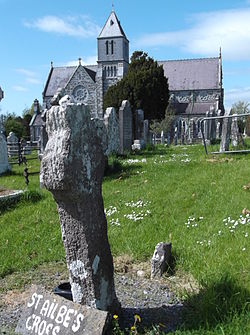Emly Imleach Iubhair | |
|---|---|
Village | |
 Cross and Church of St Ailbe | |
| Coordinates: 52°27′49″N8°21′02″W / 52.46358°N 8.35058°W | |
| Country | Ireland |
| Province | Munster |
| County | County Tipperary |
| Population | |
• Total | 302 |
| Time zone | UTC+0 (WET) |
| • Summer (DST) | UTC-1 (IST (WEST)) |
Emly or Emlybeg (Irish : Imleach Iubhair, meaning 'Border of lake of yews ') is a village in County Tipperary, Ireland. It is a civil parish in the historical barony of Clanwilliam. It is also a Catholic parish in the Archdiocese of Cashel and Emly.
Contents
- History
- Ancient times
- St. Ailbe's church
- Monastery
- Annalistic references
- Amenities and facilities
- Transport
- Community awards
- People
- See also
- References
- External links
The village is 14 km west of Tipperary town, on the R515 road which goes from Tipperary town to Abbeyfeale, County Limerick.
Emly had a population of 302 in 2016. [1]


